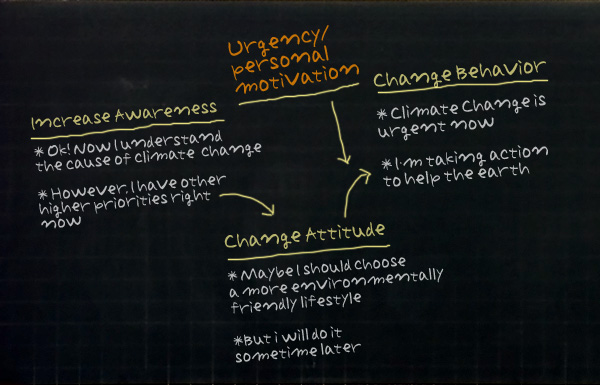Is it Spring or is it just climate change? I like to ask myself this question every time we enjoy 50° weather in the winter. Nonetheless, welcome back to my blog, and I hope you’ve been taking advantage of the warmth.
It’s been about 30 years since 154 United Nations states formed the United Nations Framework Convention on Climate Change and brought climate change to the forefront of public discourse. However, three decades later, public discourse is still the majority of attention climate change receives. Where is the action?
Even I will admit that my carbon footprint is much larger than I would like it to be. Fighting climate change is hard! That is why we need to think long and hard about how we can bridge the divide between awareness and action.
Despite widespread awareness of climate change, people have many different views as to who is responsible for reversing this phenomenon. According to a study done by a IIASA researcher, this may have something to do with different worldviews. The four identified worldviews were hierarchical, egalitarian, individualistic, or anarchical. Each of these worldviews allocates a different amount of the responsibility to the government and to individuals. Reversing climate change involves policy changes, but it also involves individual changes in consumption of energy, food, and transportation. It is hard to translate awareness about climate change into effective action if people do not agree on who should be taking action. One of the keys to turning awareness into action is analyzing the conversations that are being had, and considering different worldviews when proposing solutions. Understanding worldviews could “could help policymakers develop compromise solutions that reflect these various worldviews.”
Another problem with the disconnect between awareness and action is that climate change is not a high priority for many people. It often seems like your personal actions will not have a very large impact on the Earth, and making personal behavioral changes may not seem worth it. Additionally, according to the United Nations University, typical climate change communication tactics such as fear, moral obligation, and statistics are not effective in motivating individuals to take action. Some suggestions the university makes are making climate change issues, discussions, and solutions local, making information easier to understand, and making solutions seem “trendy.” That may seem strange, but I know you’ve probably heard of the metal straw craze. #SaveTheTurtles #SaveTheBees


However, trends fade quicker than climate change. We must find more lasting ways to encourage action. Making climate change efforts more convenient is one way to do this. People are busy, and the more accessible sustainable food options, transportation, and utility options are, the more people will be willing to take advantage of them. According to a Stanford University article, “convenient environmentalists” are people who “talk green but have lots of excuses for not buying sustainable products.” Whether they’re too expensive, or the benefits aren’t worth the hassle, the key is to appeal to their selfish interests. Emphasize health benefits, frame benefits as potential losses in not buying a product rather than buying the product. Enticing customers to go green is one way to promote action.
Individuals are not the only problem. Although nations agreed in the Paris Climate Agreement to limit climate change to below 2°C, current efforts are not enough to meet this goal. Individuals and governments have a long way to go when it comes to bridging the gap between awareness and action. Hopefully suggestions like the ones detailed in this bock will bring successful change.

I am going to love this 60 degree weather that we are about to have this week! It reminds me of back home, but that question you posed at the beginning really makes me think. I used to say that Utah weather was just bipolar, but now it’s got me thinking, is it really bipolar or is is climate change! Thank you so much for that question!